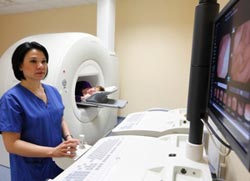Magnet Guides Camera in Capsule Through Stomach

The capsule wirelessly transmits images from inside the stomach to an image processing system where the doctor can view the images. The results of the first feasibility study have now been published in the journal “Endoscopy”. A conceptual model of the technology was shown for the first time at the United European Gastroenterology Week in Barcelona.
The prototype of the magnetically guided capsule endoscope (MGCE) system was jointly developed by Siemens and Olympus and consists of an innovative guidance magnet, an image processing and guidance information system as well as the capsule endoscope. The magnet system and the guidance of the joystick was co-developed by researchers of Corporate Technology, Olympus developed the camera. The patient swallows the capsule together with water. The patient is positioned in the system so that his stomach including the capsule is located in the center of an artificially generated magnetic field. The magnet generates varying magnetic fields in real time to navigate the capsule. The magnetic field enables the physician to control the capsule with a joystick. The cameras at both ends of the capsule transmit images from inside the stomach to the image processing system where the doctor can view the images. The capsule endoscope is approximately 31 mm long and measuring 11 mm in diameter.
A feasibility study of the MGCE at the renowned Institute Arnault Tzanck in Saint Laurent du Var (France) shows that the new technology appears to be feasible and sufficiently accurate for gastric examination and may permit endoscopic examinations that are more patient-friendly and without sedation. In a study with more than 50 people, 30 findings were detected in the stomach. Fourteen of the 30 findings were detected with both the capsule and the conventional endoscope. Ten out of 30 were located with the capsule examination only and six with the conventional endoscope only.
93% of the study participants thought the examination comfortable, 89% found it easy to swallow the capsule, and regarding future examinations, all patients questioned preferred the magnetically guided capsule endoscope over conventional gastrointestinal endoscopy.
Link to Video-Clip:
https://www.siemens.com/press/en/tvservice/index.php?tv=772&l=en
Media Contact
More Information:
http://www.siemens.comAll latest news from the category: Medical Engineering
The development of medical equipment, products and technical procedures is characterized by high research and development costs in a variety of fields related to the study of human medicine.
innovations-report provides informative and stimulating reports and articles on topics ranging from imaging processes, cell and tissue techniques, optical techniques, implants, orthopedic aids, clinical and medical office equipment, dialysis systems and x-ray/radiation monitoring devices to endoscopy, ultrasound, surgical techniques, and dental materials.
Newest articles

Innovative 3D printed scaffolds offer new hope for bone healing
Researchers at the Institute for Bioengineering of Catalonia have developed novel 3D printed PLA-CaP scaffolds that promote blood vessel formation, ensuring better healing and regeneration of bone tissue. Bone is…

The surprising role of gut infection in Alzheimer’s disease
ASU- and Banner Alzheimer’s Institute-led study implicates link between a common virus and the disease, which travels from the gut to the brain and may be a target for antiviral…

Molecular gardening: New enzymes discovered for protein modification pruning
How deubiquitinases USP53 and USP54 cleave long polyubiquitin chains and how the former is linked to liver disease in children. Deubiquitinases (DUBs) are enzymes used by cells to trim protein…



